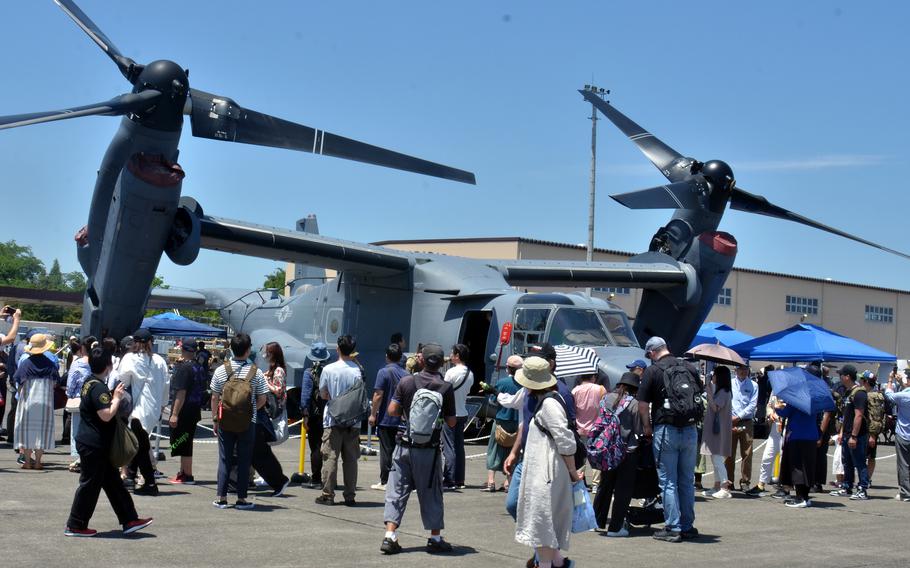
Visitors check out an Air Force CV-22 Osprey on display during the Japanese-American Friendship Festival at Yokota Air Base, Japan, May 18, 2024. (Seth Robson/Stars and Stripes)
YOKOTA AIR BASE, Japan — Japanese cities that surround this airlift hub in western Tokyo are concerned for their citizens’ safety when the Air Force resumes flying the CV-22 Ospreys stationed here.
The 21st Special Operations Squadron has yet to launch its Ospreys again, nearly six months after it lost eight airmen in a fatal crash in southern Japan.
The Marine Corps, Navy and Japan Self-Defense Forces put their Ospreys — tiltrotor aircraft that fly like airplanes but take off and land like helicopters — back into service in March, almost four months after U.S. Naval Air Systems Command grounded the aircraft.
The Air Force has not determined when CV-22 flights will resume, a spokeswoman for Special Operations Command, Lt. Col. Rebecca Heyse, told Stars and Stripes by email Monday.
In Fussa, the densely packed urban community outside Yokota’s main gate, some residents are waiting for the once-familiar clatter of the twin tiltrotors overhead with trepidation, according to a spokesman for the city’s base affairs division.
“We are concerned for the safety since there has not been sufficient explanation provided on the cause of the accident and the measures to be taken,” he said by phone Wednesday.
An Osprey parked along the Yokota flight line was a popular attraction at the base’s annual Japanese-American Friendship Festival over the weekend.
Mamoru Kohinata, an airplane buff who owns a bar in nearby Hachioji city, was in line for a closer look at the aircraft. He’s no fan of the Osprey, he said.
“It is dangerous and noisy,” he said. “I like planes.”
Despite concerns expressed by Kohinata and others, the Ospreys drew a crowd three-deep, many taking photographs, during the festival. The tiltrotors attract crowds at similar events at U.S. bases on Okinawa, where an Osprey fan club has more than 12,000 Facebook followers.
Shortly after the Nov. 29 crash, which involved a Yokota-based Osprey, the Air Force cited equipment failure as a contributing factor but has not been more specific. The Osprey’s unique design was plagued with a clutch problem deemed a factor in several mishaps, including a crash in June 2022 that killed five Marines in California.
U.S. officials provided their Japanese counterparts with a detailed explanation of the Nov. 29 crash, according to Japanese Defense Minister Minoru Kihara in March. That information has not been made public.
A report on the incident just off Yakushima, an island south of Kyushu, is in its final stages, Heyse said by email Wednesday.
“We expect it to be released sometime this summer,” she said.
The U.S. and Japan agreed to coordinate on a timeline for returning the aircraft to service in Japan, Kihara said in March.
Fussa was last updated on the Ospreys’ return to operations in March, the base affairs spokesman said. Some Japanese government officials may speak to the media only on condition of anonymity.
That month, a liaison council of five cities and a town around Yokota asked U.S. and Japanese authorities for details of the accident’s cause and safety measures that will be taken for the Ospreys’ operation, the Fussa spokesman said.
“While the accident investigation is ongoing and there has not been sufficient information provided on the cause of the accident, safety measures, and measures to prevent recurrence, we regret and are deeply concerned that gradual resumption of the operations of the CV-22 Osprey assigned to Yokota Air Base will further heighten the anxiety of residents living near the base,” the council’s March 15 letter states.
Since then, no additional information has been provided to surrounding communities, the spokesman said.
A spokeswoman for the 353rd Special Operations Wing, headquartered at Kadena Air Base, Okinawa, said the wing’s Ospreys will fly under restrictions designed to ensure their safety.
“We are not currently flying our CV-22 Ospreys on Yokota, but when we do, you can expect our restrictions to be in line with the joint program officer [Naval Air Systems Command] and designed to ensure safety for the crews operating the CV-22,” Capt. Rachael Parks said in an email Thursday.
“All flight operations will include maintenance and procedural risk mitigation controls,” she added.